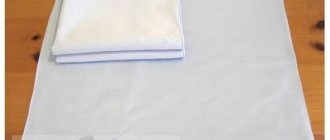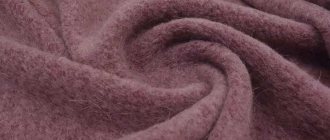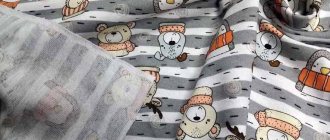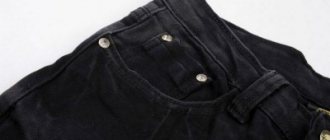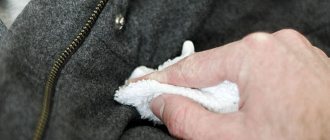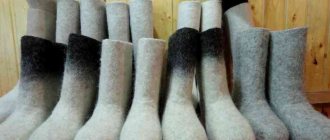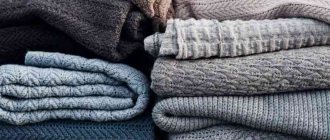Tulle is a lightweight mesh and transparent fabric, several layers of which provide incredible volume. This material is used to sew a full skirt, ball or evening dress, wedding dress or veil.
Products made from tulle can turn every girl into a princess, but fairy-tale material requires special care. In this article we will learn how to wash and iron tulle to preserve the fluffiness and color of the material.
Before washing or ironing any item, be sure to check the label. He will indicate the best way to wash a dress or skirt. He will tell you whether it is possible to iron tulle clothes. You can find the explanation of the symbols here.
What kind of fabric is it and what is it made from?
Tulle is a type of mesh fabric. For production, polyester and nylon fibers are used.
This material has a shiny or matte surface, and is covered with embroidery, patterns, gold or silver plating. The assortment includes a variety of shades from pastel to rich. There is a variety of highly stretchable “tulle jersey” with the addition of spandex.
Tulle, characterized by large cell sizes, is used to create voluminous petticoats and various decorative elements. The fine-mesh, softer and well-draped variety is used for sewing dance costumes, ballet tutus, dresses - evening, ballroom, and wedding. It is in demand for making bridal veils, carnival and festive dresses.
Individual elements - bows, flowers, ribbons made from this fabric are used to decorate the setting for banquets and weddings. A veil of airy tulle adorns elegant ladies' hats.
What is tulle
A few tips on how to prevent wrinkles in the material
To avoid wrinkles, many housewives manage to ruin the fabric, since caring for it is very difficult. Quite rarely in everyday life, a business person who devotes himself only to work and home puts on a dress or skirt made of tulle. Usually this happens only on holidays, and preparations for such an event are usually made in advance. The only problem is that you can’t sew the torn fabric back together yourself, since the seam may be noticeable. The studio probably knows how to cope with this task without noticeable signs of material rupture.
Rules for washing products
To restore the freshness of tulle products and remove any stains that have appeared, you should follow these rules:
- Given the synthetic base, the use of excessively hot water is excluded. They are guided by recommendations that indicate a temperature in the range of 30-40˚C.
- Before washing, inspect the product and remove removable decorative details - flowers, boutonnieres, brooches, bows.
- You should not use detergents designed for colored textiles for white items.
During the washing and rinsing process, strong friction and twisting are eliminated.
How to starch tulle at home
Tulle is starched using a soft method, which is also suitable for bedding, blouses and dresses.
What will you need for this?
For 1 liter of product we take 0.5-1 teaspoon of starch, which was diluted with cold water. Add to hot water, stir until a transparent paste with a homogeneous composition appears. If the mass has acquired a cloudy hue, boil it for 2-3 minutes over low heat. Add a little water, stir and cool.
Important! To ensure even distribution, stir it several times. The maximum effect of the procedure will be more pronounced if you dip the tulle into a solution at room temperature.
Work progress
- Immerse the tulle fabric in the resulting product for 15 minutes.
- At the end of the procedure, lightly wring out the fabric, straighten it and let it dry.
- Before you start ironing the product, you should slightly moisten it and wait until the fabric softens. The iron temperature when ironing should not be too high.
Wash by hand
If a tulle dress or skirt has lost its former freshness during wear, resort to hand washing.
It is better to wash a tulle dress by hand
Algorithm for hand washing small items:
- Pour warm (30˚C) water into an enamel basin - 6 liters.
- Dissolve detergent varieties in it - 2 tbsp. l., selected in accordance with the color of the fabric.
- Soak the product and begin to wash it without twisting or squeezing, rinsing it in a soapy solution. Heavily contaminated areas should be carefully rubbed with your hands.
- Rinsing is carried out first in warm and then cold water, to which an air conditioner is added, which reduces the electrification of synthetics.
For colored products, table vinegar (9%), a teaspoon of which is dissolved in 10 liters of cold water during the last rinse, will allow the richness and richness of shades to be restored.
To wash a voluminous dress, fill the bathtub to a third of its volume with water. Dissolve a product designed for delicate synthetics. Completely immerse the product. Using a soft sponge, carefully go over all surfaces of the dress. Leave it soaked for an hour and then rinse thoroughly.
ARTICLE FOR YOU
How to wash Tencel clothes and bedding: in the washing machine and by hand
If the outfit has a lot of decorative accessories sewn on it, then it is advisable to place it above the bathtub on a hanger. Water with warm water from the shower and wipe the fabric with a soapy soft sponge, removing dirt. Then wash off all the residue, directing the shower jets from above.
How to maintain the shape and fluffiness of tulle
To ensure that items retain their shape for a long time, clothes are stored straightened on a hanger. Alternatively, you can use the old method of starching the hem. It will effectively preserve the fullness and volume of the skirt. You can use starch only for clean things! You can starch the hem as follows:
- The solution is prepared from potato, rice or corn starch. For a liter of water for light items, take 5 grams of starch, for heavier and tougher items - 10 grams;
- A tablespoon of starch is thoroughly dissolved in a glass of water and then 0.5 liters of boiling water is added with constant stirring. The composition is put on fire and cooked under the lid until it becomes transparent. Strain the solution;
- The resulting solution is poured into cold water and a skirt or petticoat is lowered there. After a few minutes, take out the clothes and lightly wring them out using squeezing movements. Do not twist the material!;
- After this procedure, give it the desired shape and leave it to dry, hanging the product from your belt. The dried outfit is finally ironed or steamed.
After prolonged storage, use or transportation, tulle items may lose their fluffiness. To restore a presentable appearance to a skirt or dress, hang the items on a hanger and straighten out every fold, frill and stripe with your hands. If this does not help, you can use a steamer or gently iron the items.
The optimal care for tulle items is hand washing, ironing and steaming with a steam generator or drying in a bath with boiling water. Proper and gentle care of such fabric will ensure a long service life of the products. It will retain the shape and splendor, color and attractive appearance of tulle clothing for a long time.
Washing in a washing machine
When deciding whether to machine wash contaminated tulle products, first study the information reflected on the label. Proceed with the procedure if the permission icon is present.
Machine wash on delicate cycle
Set to delicate mode. The temperature is allowed at 30˚С. Spinning the mesh fabric is not needed, so it is turned off. In units where it is impossible to perform this function, the minimum speed is selected.
Machine drying is contraindicated. A conditioner is added to help soften the structure of the material, preventing wrinkles.
The product is placed in a fabric bag. If tulle clothing contains elements of beads, seed beads, or sequins, then gauze patches are sewn onto them with large stitches.
How to smooth a veil correctly
There are various ways to smooth out a veil. But, alas, there is no universal solution. For some products, a hairdryer or spray bottle is suitable (usually those decorated with beads or sequins), while others can be ironed with a regular iron, after placing napkins or a thin towel on the fabric.
With iron
You can iron a tulle veil with an iron, but this is done extremely carefully. The first thing you need to do is set the required temperature range on the iron. If you look at the marks, it should be set to one or two, the mode is for synthetics or delicate fabrics. A one usually copes, but if the creases are serious, then they switch to a two.
Next you need to persuade additional fabric. Materials created specifically for ironing synthetic soft fabrics are sold in specialized stores, and can also be ordered online. But if this is not possible, then ordinary gauze will do. It is rolled up in several layers and placed over the entire surface of the tulle.
The gauze must be used wet, but it should not be so wet that you can squeeze out the water.
The tulle veil is placed on a flat surface, covered with several layers of gauze and ironing begins. It is advisable to check on the most inconspicuous part of the veil how exactly the material will behave when exposed to temperature. As a last resort, if a burnt spot remains, it can be disguised with a brooch or hair curls.
Hair dryer and spray bottle
This method is used if the creases are not too strong, and there are decorations on the veil that can simply melt under the influence of the iron. Fill a spray bottle with warm water; you can add a couple of drops of the composition to soften the tissues. Distribute evenly throughout the material, paying special attention to the most problematic areas. After this, proceed to drying with a hairdryer. It is kept no closer than 15 centimeters from the fabric, the stream should spread evenly. Do not use very hot air, as it can damage the fabric fibers.
Hot bath and shower
One of the simplest ways, but at the same time effective, is to hang a veil in the bathroom. You need to close the doors tightly and turn on the hot water faucet in the bathroom. Naturally, hot air should not get directly onto the veil - it will burn the fabric and ruin its structure. For ordinary tulle, 15 minutes of such exposure is enough. The main thing is that there are no foreign odors in the bathroom or shower. If they get into the texture of the fabric with the help of hot air, it will be difficult to get rid of.
See also
How to properly stick protective glass on a tablet at home
Hot kettle
Using a hot kettle is convenient if a local effect is required. Clean water is boiled and a certain place on the veil is brought to the spout of the kettle. The main thing is to hold the fabric and not allow it to be less than 15 centimeters from the spout.
Steam generator
A special steamer initially saves time. It is used not only for smoothing tulle, but also for other delicate fabrics. For example, the device can handle silk, corduroy, help smooth out a jacket made of genuine leather or leatherette, and process a fur outerwear. Steam generators cost a lot, their price is approximately equal to an average iron. But for those who prefer to dress in fine fabrics, such an acquisition is necessary. The steamer works with an item that is placed strictly vertically. Use a regular hanger, and secure the veil firmly with pins or hairpins.
Clean water is poured into the steam generator and plugged into the network. Wait until the corresponding signal appears that the required indicators have been achieved - then steam will begin to be produced. The steam generator works up and down, without making unnecessary movements. There is no need to rush; to steam a thing, you need to hold the device over a certain location for 2-3 seconds. But you cannot leave it for 10 seconds, as the structure of the tulle may be damaged.
When working with a steam generator, certain safety rules must be followed.
Wear protective gloves on your hands to prevent accidental burns from the steam. Under no circumstances should the steam flow be directed towards the face area. If there are sequins or beads on the veil, then it is impossible to expose them to a steam stream for a long time - they may come off, or the color will become less bright, the paint will peel off.
Contacting specialists
Contacting specialists will help you get excellent results without risk. They use special steamers that are highly effective, but at the same time absolutely safe for delicate fabrics. Of course, you will have to pay for the services, but looking impeccable at the wedding ceremony is worth it.
Detergents
It is not recommended to use tulle powder during the washing process, since there is a possibility that it will not completely dissolve in warm water and will settle in the cells of the mesh fabric, causing it to turn yellow.
More gentle detergent compositions are selected. Most often this is a concentrated gel: Kao Emerl, Care & Repair, Attack Emerl.
Washing gel
Eco-friendly liquid detergents that do not deform fibers are recommended: BIO-Sensitive, Winniʹs, Sodasan, Lion Acron, Dalli fein and color, Lion Akron.
Iron or steam generator?
If you have the opportunity to use a steamer at home, then you should definitely prefer it. It can easily handle all creases even on voluminous curtains, and not just on a wedding veil or full skirt. Gentle steam will not spoil the delicate structure of the fabric, but will easily return the ironed look to the product.
But if there is no steam generator, you will have to suffer with the iron. Exactly like that - long, systematically, patiently, carefully. A large item like a wedding dress will take at least an hour of time and patience.
- The iron must be set to the minimum temperature; do not pour water into the special compartment.
- Place a soft towel on the ironing board.
- Thick fabric is placed on top of the tulle, which will help avoid contact of the delicate mesh material with the sole of the iron.
- Ironing of the dress begins from the front, with large parts, such as the bodice and skirt, gradually moving to smaller ones - sleeves, collar, ruffles.
- It is more prudent to start with the bodice, since a full skirt with many folds is much more difficult to iron, but it is much easier to wrinkle if the top is ironed after it.
- If the top of the dress is decorated with beads, rhinestones or embroidery, a soft towel should be placed on top for protection.
- To iron sleeves, you will need a special stand, which is included with each ironing board.
- After ironing the sleeves, you need to insert tubes of thick paper into them to maintain their shape.
- It is important to constantly check the ironed areas to see if there are any minor dents or wrinkles that could ruin the entire festive mood, and, if necessary, iron out the noticed flaws again.
- The ironed product should be hung on hangers.
Advice
Before ironing tulle clothes, make sure that the soleplate of the iron is perfectly clean and smooth, without any roughness. Otherwise, you can not only stain the fabric, but also damage its delicate texture.
It will be much easier to iron a skirt or veil, since their shape and size will not create unnecessary difficulties in the work.
Bleaching things
Airy tulle products can lose their snow-white appearance after some time. In such a situation, bleaching is carried out, choosing oxygen-containing varieties that do not deform the delicate fabric.
Most often, liquid Vanish Oxi Action is recommended, which effectively removes a variety of contaminants.
For items that are not machine washable, soaking is practiced.
Pour warm (30˚C) water into an enamel basin and dissolve the bleach. It is calculated that you need to take 50 ml of Vanish per 2 liters of water. Immerse the product completely and leave for 6 hours. If there are noticeable stains, first apply a small amount of bleach to this area of the fabric, leaving for 5 minutes. The bleached item is thoroughly washed with clean water.
ARTICLE FOR YOU
How to properly wash cross stitch at home
If machine washing is carried out, then add 100 ml of Vanish in accordance with the instructions.
How to steam?
There are several options for steaming a dress at home: steam, a steamer, and an ordinary iron with wet gauze.
To rid your wedding outfit of bumps using steam, you first need to fill the bathtub with hot water. The dress is placed on hangers and then placed above the water at a height of twenty-five centimeters. After the wrinkles are smoothed out, you need to hang it out for three to four hours so that it dries completely. How long it will take for the outfit to iron out depends on the density of the fabric. This method has some disadvantages:
- When steam penetrates the fibers of the fabric, it becomes heavier, absorbing a large amount of moisture. This may cause the dress to fall into the water. Care must be taken to ensure that this does not happen.
- If the outfit has an abundance of different rhinestones, it is better not to use this method, as they may come off.
- This method is a bad option for dresses made of heavy material, as well as for dresses with fluffy multi-layered skirts.
Steamer
The most effective and simple method that any housewife can use. A vertical steamer is capable of efficiently smoothing even the most fragile element of a dress. Smoothing occurs as follows.
- Liquid is poured into a special container located in the device. Then you need to turn on the steamer.
- The outfit is placed on hangers to make it easier to iron.
- The steaming process begins from the lower tiers. It is necessary to steam first large areas of the product, and then smaller elements.
- After completing the process, you should leave the outfit hanging for three to five hours.
Steaming occurs in ten to twenty minutes, the device saves time. The device also perfectly fights a variety of microorganisms, gets rid of germs, dust mites and viruses that are on clothes. The dress becomes perfectly smooth, there are no shiny areas on the treated fabric. Smoothes out even the smallest creases.
Iron and gauze
This method is used if the housewife does not have a steamer. It is quite risky, because if you are not too careful and inattentive, you can ruin the dress. The correct mode is selected on the iron (which depends on what fabric the outfit is made of). It is best to use the minimum temperature so as not to harm your clothes. Before starting the process, it is necessary to thoroughly clean the soleplate of the iron, as it should be as clean as possible. In order for the dress to be smoothed out well and not spoiled, you need to place several layers of gauze fabric and iron it from the inside out.
Steaming an outfit with an iron is quite difficult, so it is better to ask someone for help and have a lot of patience.
Drying
Washed and rinsed garments and other tulle products are not wrung out. They are placed above the bathtub on hangers to allow water to drain.
Can be attached directly to the rope using clothespins. In this case, the item is hung by the belt or shoulder seams to avoid noticeable marks from clothespins after drying.
You can dry the skirt in a straightened state on a horizontal plane, placing a terry towel under it. Avoid exposure to midday sunlight and exposure to hot streams from heating devices.
A fluffy dress on hangers can stretch out under its own weight, so it is advisable to lay out a wall-mounted slatted dryer horizontally and carefully place it on it.
How to dry a fluffy dress
Caring for tulle
- Handwash only. Squeezing a little. We decided to wash it in a machine - hand wash mode, at low speeds and at a temperature not higher than 40 ° C.
- Tumble dry . On the "drying" mode. The operation of this mode is based on the principle of a steam generator.
- Let dry in a straightened state . It is better to hang them on hangers so that the room is well ventilated.
- Rinse in vinegar . If a colored tulle dress has lost its former brightness, rinse it in vinegar water (for 10 liters of water - 2 tablespoons of vinegar).
Wash tulle at a water temperature of no more than 40 °C.
Ironing
If necessary, you can iron the tulle product using an iron without steam through a thick cotton napkin. The temperature is set to no more than 100˚C.
First, they tidy up the bodice, then move on to the bottom. If there are sleeves, then before ironing, put a special device inside, which is included with the ironing board. To prevent them from becoming wrinkled in the future, insert tubes folded from white thick paper.
It is easier to refresh a voluminous dress and restore smoothness more easily if you use a steam generator. It will remove creases and make clothes look fluffy. The steam has a gentle effect without deforming the delicate fabric. The ironed product is placed on hangers.
In the absence of a steam generator, people's advice will come in handy. The bathtub is filled with hot (about 100˚C) water, closing the door to the room. When it is filled with steam, hang the clothes, keeping them in such conditions for two hours.
Ways to return pomp
After long-term storage or transportation in a suitcase, tulle products may lose their fluffiness and become significantly wrinkled. Simple steps will help restore things to their original appearance and beauty. First of all, the skirt needs to be hung by the belt on a trouser hanger with clothespins. This will help you work with it easily and have access to any side of the product. There are several simplest ways:
Evening dress in pleasant colors
- If there is a steamer, the skirt is treated with it, straightening folds and smoothing out creases. After the procedure, you need to wait for the product to cool completely.
- Treatment with wet hot steam can be carried out in the bathroom. It places the skirt on a hanger, draws hot water into the bathroom, and closes the door so that hot steam accumulates inside the room. After 20 minutes of staying in a damp room, you need to straighten the folds with your hands, and then leave the skirt in this form to dry.
- Another trick to straighten out wrinkles is to use a hair dryer and a spray bottle of water. Water is sprayed onto the fabric and dried using a hairdryer. This process is identical to steaming.
- Minor dents can be removed using steam from an iron. If the iron is not equipped with a vertical steam function, then the skirt is laid out on the surface of the ironing board, steamed and left to dry.
- The steam from a boiling kettle can also be used to smooth out small wrinkles, so as not to have to process the entire outfit.
- You can simply iron the skirt. However, actions must be as careful as possible. The heating of the iron is set to the lowest level, intended for ironing synthetics. You will have to be patient, as this option is quite labor-intensive and time-consuming due to the presence of many frills and folds.
It is important to know! After the steaming procedure, the edge of the skirt should be ironed along the entire length with a warm iron using a finishing satin ribbon or bias tape. Brocade or metallic edgings are susceptible to ironing with high heat due to possible deformation.
At the end of the procedure for restoring volume and straightening folds, it is advisable to use an antistatic agent. It will relieve the canvas from the accumulation of static electricity.
As can be seen from the proposed review, putting tulle products in order is quite simple. The rules for caring for them will not cause much difficulty. However, the process can be lengthy and labor-intensive due to the volume of items and the presence of many folds in them.
Another interesting article: How to remove traces of sunflower oil from clothes.
How is Eurofatin different from tulle?
What fabric is called Eurofatin? Soft or hayal tul is a soft mesh with small cells, which is characterized by a lack of shine and the ability to form beautiful folds. This particular material is used for skirts and dresses that are fashionable this season. Its average cost is 160–250 rubles. per linear meter (depending on the manufacturer).
Classic tulle is stiffer, the cells are large. The fabric holds its shape perfectly. If you need to sew a fluffy petticoat or a voluminous decorative element, buy this fabric, especially since its price is rarely more than 100–150 rubles/m. Due to its low cost, classic tulle is often used to decorate children's carnival costumes, in the production of toys and souvenirs.

